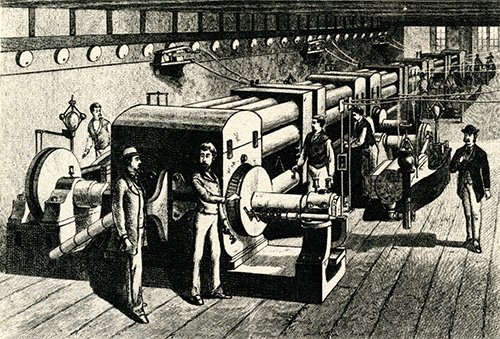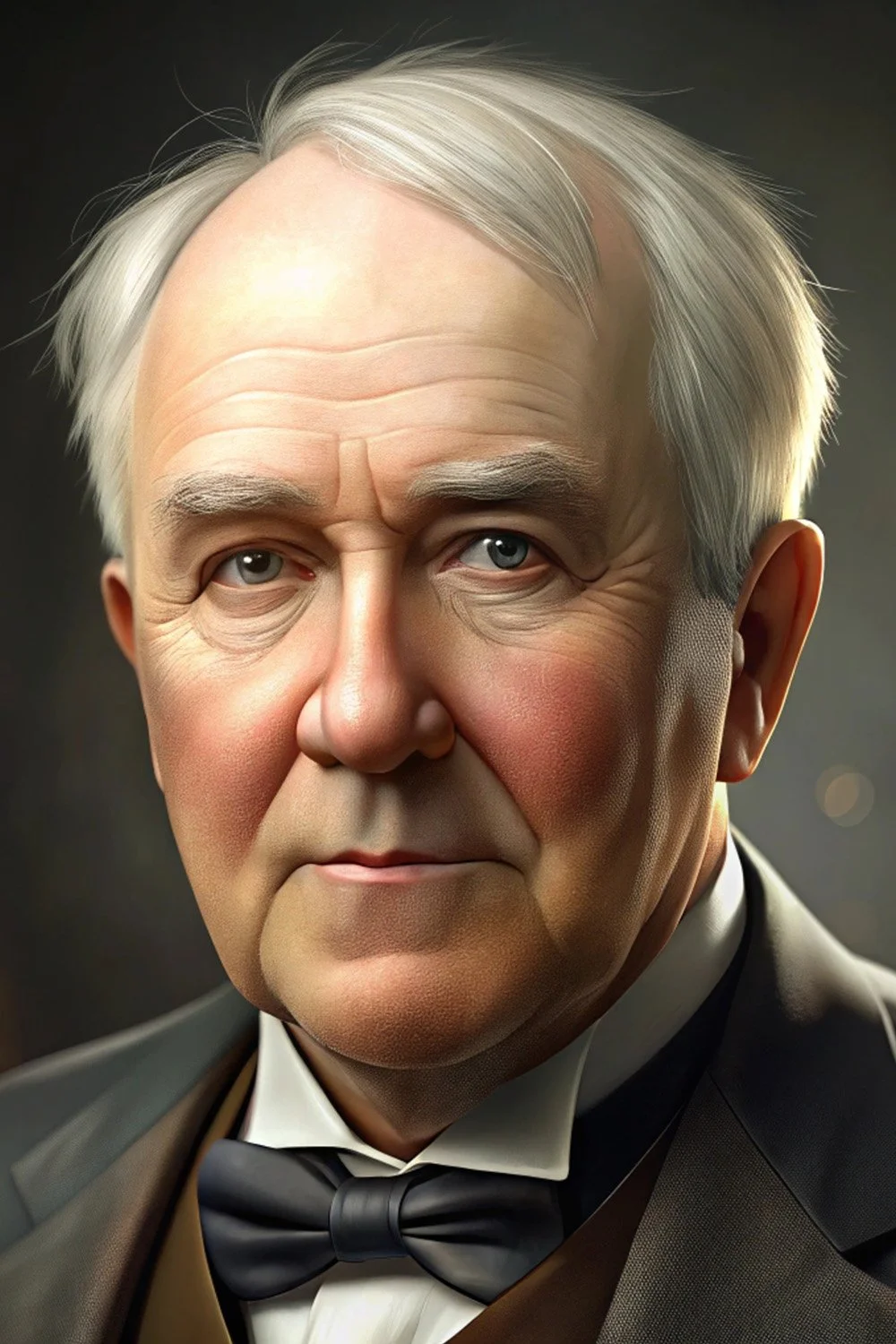Electric Utility Glossary
A B C D E F G H I J K L M N O P Q R S T U V W X Y Z
Thomas Edison, the First Electric Utilities and the Birth of the Electric Age
Author: Frank Skinner
Published: August 15, 2025
Who is Thomas Edison?
The light bulb, one of mankind’s greatest inventions, is just one of the many things that Thomas Edison helped create. The music recording industry, the movie industry, and the telecommunications industry were all born from Edison’s inventions or inventions he improved upon from others. It’s truly remarkable what he and his team accomplished and those accomplishments overshadow one of Edison’s lesser known creations, the centralized power generating system. In modern terms, the electric utility system.
Edison was someone who had a vision that included electric products for the general public as well as the underlying electric system that would be required to power everything.
But Edison’s path to the first practical light bulb and fist electric utilities was anything but straightforward.
Thomas Edison’s Early Life
One of the world’s greatest inventors had a challenging early childhood and school life. According to W.H. Meadowcroft in the story, Boys’ Life of Edison, he writes that one of Edison’s early teachers referred to Edison as being addled, which meant he was mentally unable to think clearly. Edison also had numerous near death accidents as a child. One of those near death accidents occurred when he was experimenting with fire in the family barn and he accidentally burnt it to the ground. Edison survived the fire but according to Meadowcroft, Edison was publicly caned in the town square by his father. Edison became very sick in his childhood and left conventional schooling and was homeschooled by his mother for a period of time.
Edison’s mother encouraged experimentation and investigating the natural world. At an early age he was using basic science equipment to analyze material properties and chemical reactions in his basement. This constant learning and experimenting would underpin his entire career.
At the age of 14, Edison got a job working as a newsboy on a train helping to deliver newspapers to the train’s destinations. Edison possessed an unusual entrepreneurial spirit. He bought a used printing press, figured out how to work it, and then created his own newspaper flyers on the train while the train traveled between destinations. He would sell his newspapers along with the newspapers he was delivering.
The only issue was that it wasn’t his job to secretly print his own newspapers on the train. Additionally, there was an accident with his printing materials and chemicals on the train and a fire broke out. According to Meadowcroft, the train conductor was very mad at Edison and hit Edison in such a way that it left Edison partially deaf for the rest of his life. Edison was fired from the train company and now permanently hard of hearing.
Edison and the Telegraph
What came next for Edison was the emerging field of telegraphy. He transitioned to working as a telegraph operator at a local merchant store. The role of telegraph operator is one that Edison did for several years, but he moved to different telegraph operator jobs frequently.
Edison’s penchant for tinkering eventually led to him making improvements in things like telegraph repeaters that could automatically repeat and relay information over longer distances. He also developed a way to send multiple signals back and forth at the same time, increasing the capacity that telegraphs could handle. He also created a way to turn the dot and dash coding into text characters that could be printed on paper, greatly improving the effectiveness, speed and accuracy of incoming messages.
Most of the money Edison made as a telegraph operator went into science books, lab equipment and materials for experimentation. He did begin patenting certain inventions during this time, with his first patent coming in 1869 at the age of 22. It was also during this time that he had acquired a collection of books from Michael Faraday that covered Faraday’s seminal electricity experiments and findings.
In the middle to late 1800s, electricity was a fringe field in science. Lighting, too, was an emerging field and while several inventors created things like arc lamps prior to Edison, the lamps did not light for very long and they were impractical to make and use from a commercial product standpoint.
Edison’s Light Bulb Was Only Half the Equation
Edison had established enough wealth to create his own lab and hire researchers to help him with new inventions. Specific to electrified light, over 10,000 substances were researched by Edison and his team, including trips to far flung destinations like Brazil and Japan, to find materials that could help make sustained electrified light. All that experimentation failed to produce sustained lighting. It wasn’t until Edison used carbonized paper as a filament that sustained light was created.
Identifying these unique material properties was a huge breakthrough and Edison’s team kept refining the light bulb and filament to where they could reliably light up for hours.
Edison was then able to commercially manufacture, sell and install his lighting to businesses and factories where both lighting and power generation were done on site at the building.
Edison, above all else, created the first practical lighting that could be turned into a real product used globally. He also had a vision for lighting the world and he knew that the light bulb was only half the equation. The other half was how to light the bulb from a central power source rather than making power generators at every building.
A historical illustration of the first central power electric utility in New York City, circa 1882.
Edison and the Pearl Street Generating Station
While different types of centralized power systems were being implemented during this time, Edison’s Pearl Street Generating Station in New York City stands out as a first because it did more than just light up a few public street lights. It lit up hundreds of bulbs across numerous buildings, all electrified from a central power generator and it could do it reliably for hours and days. Up until this time, other lighting systems could only operate for a few hours in the evening.
Edison’s first generating station took several years to complete, including the buildout of underground power cable conduits used to power the area. All buildings had to be wired for power and then outfitted with light switches so customers could control when they used the lighting.
Edison’s electric system used direct current (DC), which was more understood at the time. This was an important distinction because Edison engineered his business model around producing DC current. His company helped build numerous power systems in different areas using the DC current approach. However, similar to how Edison made improvements to the original telegraph, other inventors were making improvements in understanding how to use another type of current called alternating current (AC). AC was known but it was less understood at the time.
AC vs DC and the Current Wars
In one of history’s collisions between two great minds, inventor Nikola Tesla eventually crossed paths with Edison. Edison gave Tesla a job, which included making a DC power generator more efficient. Tesla completed the task but during Tesla’s time with Edison, the topic of AC vs DC current came up frequently.
Both Tesla and Edison were influenced by the earlier work of Michael Faraday. Tesla’s view was that AC current was the future because of how it scaled and could be used long distances. Edison’s view included his significant investment in making DC current succeed as the power method of choice. Tesla and Edison had a falling out and they split ways.
Tesla eventually landed with the Westinghouse Corporation and began implementing AC central generating electric utility systems that competed head to head with Edison’s DC electric utility systems. While the competition was heated, AC current eventually won out and became the electric system of choice because it was easier to build out and more cost effective to operate. DC had limitations at the time, like a 2-mile radius of transmitting power. Ultimately, the infrastructure needed to make a DC electric system work wasn’t viable and Edison’s initiatives lost out to Tesla and the onset of AC current.
Birth of the Electric Age
Edison’s work and the work of his team helped build out the first industrial and commercial centralized power systems. They then grew that knowledge and created centralized power utility systems that could provide distributed power to customers from one central power generator. While DC current utility systems ultimately were overtaken by AC current utility systems, Edison and his team were still a major catalyst in how the early electric systems evolved and they created more products that could run on the electric system.
Electric Utility Glossary Navigation
Thomas Edison, 1847-1931


